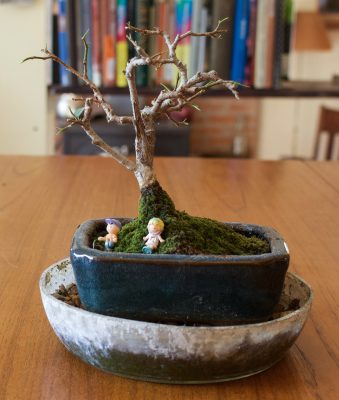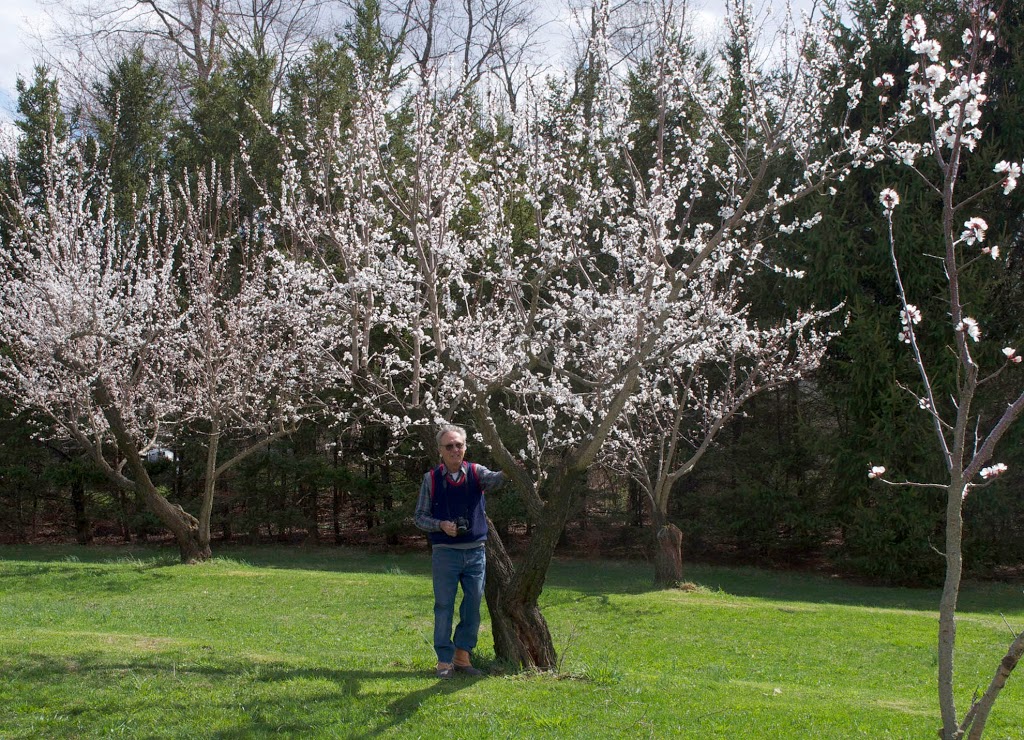A book giveaway, a copy of my book GROW FRUIT NATURALLY. Reply to this post with what fruits are most and least successful in your garden or farmden. Also tell us what state you are in (as in NY, OH, CA, etc., not happiness, wistfulness, etc.). I’ll choose a winner randomly from all replies received by March 23rd.
———————————————————
A coming bout of colder weather notwithstanding, my weeping fig (Ficus benjamina) knows and shows that spring is around the corner. Buds along and at the tips of stems are stretching and showing some green of new leaves beneath their folds. I’m called to action.
The reason for this call is that my weeping fig, although it could soar to 75 feet outdoors in tropical climates, is in a small pot being trained as a bonsai. Now that the plant is just about ready to grow is the time to cut it back so that new growth remains proportional to the size of the pot, the roots, and the dictates of design.
At three and a half years old, my tree is only 6 inches high — and I want to keep it that small. Its pot, after all is only 4 inches long by 3 inches wide, and an inch deep.
Before I even get to the stems, I cut off all the leaves. True, this is not good for a plant, but my plant is healthy so can tolerate the stress. I go through the trouble of snipping off each leaf because that dwarfs, to some degree, new leaves that are about to emerge, keeping them more in proportion to the size of the plant.
Whoops, I just checked a book (The Pruning Book by Lee Reich) which states that the leaf pruning is best done after new leaves fully emerge. Oh well, I’ll leaf prune again as soon as the next flush of growth finishes. (Tropical plants, in contrast to plants of cold climates, typically have multiple growth flushes each year.)
With leaves pruned off, time to move on to the roots. Since the plant was last re-potted, a year ago, roots have thoroughly filled the soil in the small pot. There’s little or no room for new root growth, and new roots are the ones that drink in water and what few nutrients are left in the old soil.
The only way to make room for new soil and root growth is to get rid of some old soil and roots. I tease out old soil from among the roots and then prune away about a third of the old roots. With that done, I pack new soil into the pot, just enough to put the plant, with its surface mat of moss still in tow, sitting at the same level as before the root pruning.
The stems need little pruning. I snip off a crossing stem here, one reaching too far over the edge of the pot there, and another that threatens to extend too far skyward. Although stems made little growth over the past year, they, and especially the trunk, did thicken, helping to give the little tree an appearance venerable beyond its years.
————————————————
I haven’t looked, but my guess is that my fruit trees are also beginning to feel the effects of impending spring. Bouts of warm weather are the driving force in this case. One week we have highs in the ‘teens or twenties, another week highs are in the 40s or 50s. Back and forth through winter.
Plants went into winter well able to resist enticements of warm weather. That’s because until they’ve experienced a certain number of hours at chilly, not frigid, temperatures, they remain dormant and unwilling to grow. Once reaching about 1,000 hours total accumulated exposure to temperatures between 30 and 45°F., they begin to de-harden, that is, become less resistant to cold and more ready to grow.
Plants vary in the number of hours they need to fill their “chilling” bank, some needing a couple of hundred hours, others needing over 1,000 hours. The gut reaction would be to surmise that plants from colder climates would naturally require more chilling hours before they would begin to grow. That’s generally
true, but it ain’t necessarily so. In some very cold regions, spring comes on quickly without looking back, and the growing season is short. Fruit plants adapted to such regions must be ready to grow at the first breath of spring if they’re going to have time to ripen their fruits within the growing season. Just a little chilling at the beginning and/or end of the season is all they need.
With most fruit trees, flowers are the first evidence of awakened growth. But if they open too early, subsequent cold turns their colorful petals to brown mush. Dead flowers also cannot go on to become fruits.
I admit to being somewhat foolish for planting an apricot tree, a tree native to Manchuria, a region that experiences those cold winters and quick, steadily warming springs. The climate here in the Hudson Valley (and over most of continental U.S.), and especially at my less than perfect site for fruit-growing, has a good chance of fooling apricot trees into acting as if cold weather is past long before it actually is. My foolishness won’t be in evidence this year, though, because the tree is still too young to flower.
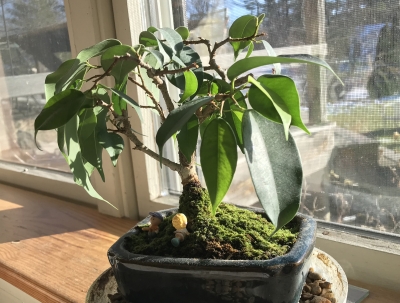

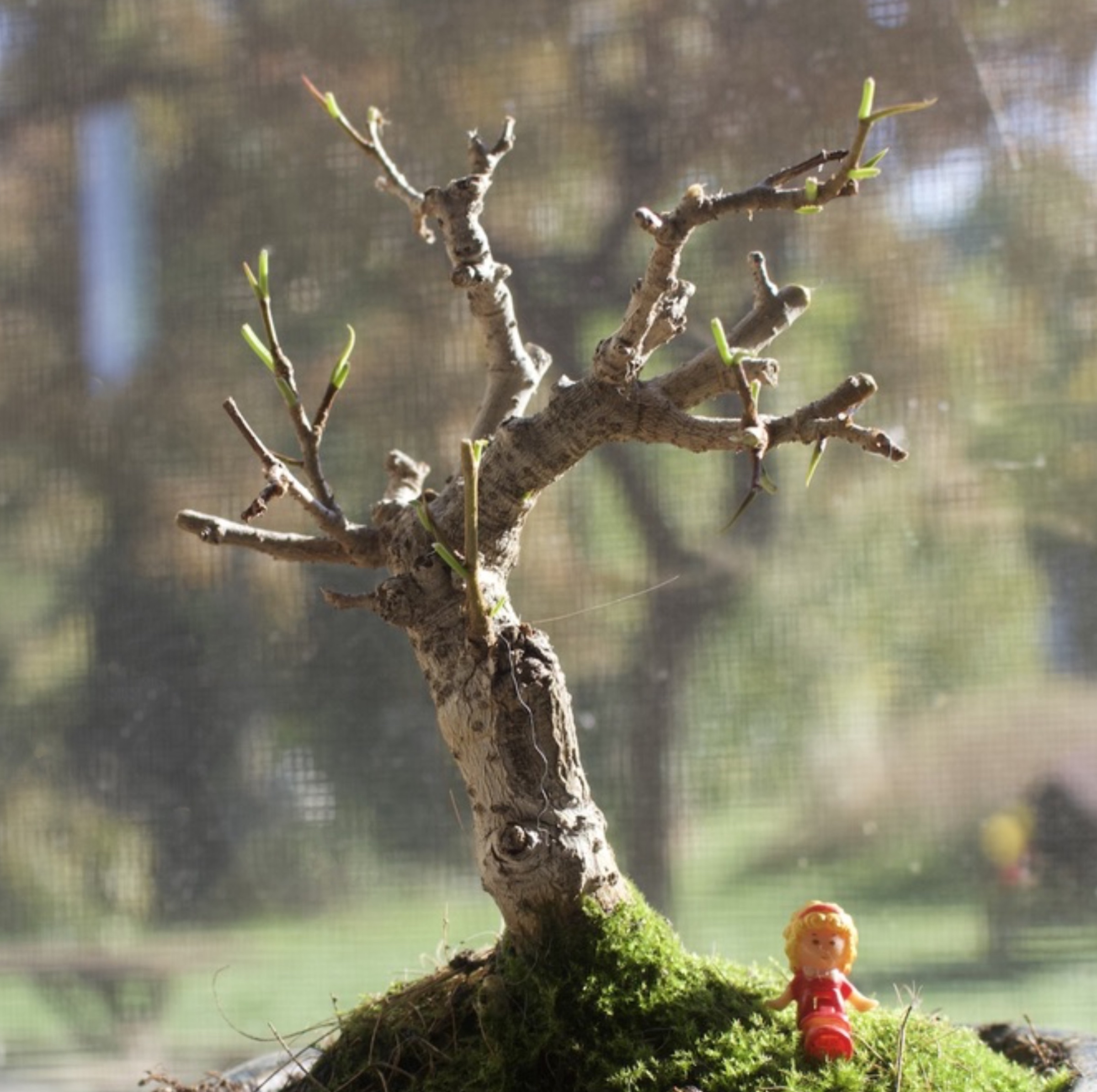
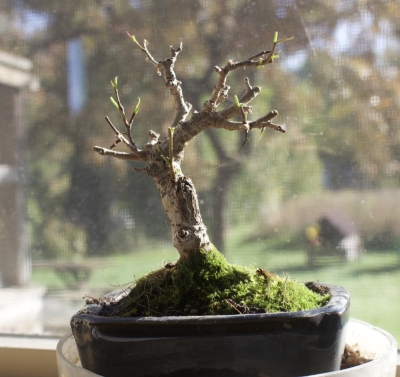
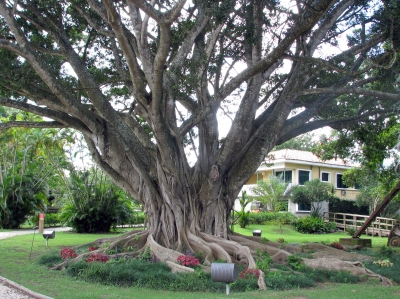
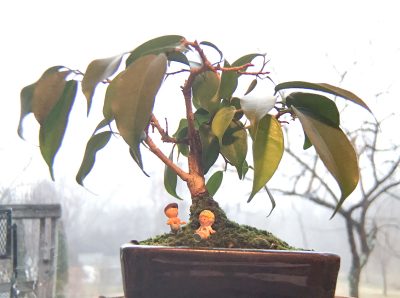 Moss carpeting the soil beneath it and creeping up the trunk complete the picture. I’ve made and am making baby ficus into a bonsai.
Moss carpeting the soil beneath it and creeping up the trunk complete the picture. I’ve made and am making baby ficus into a bonsai.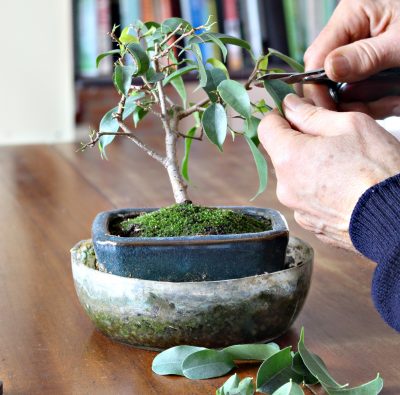 Clipping the leaves accomplishes two goals. First, plants lose water through their leaves so removing leaves reduces water loss (important in consideration of the next celebratory step).
Clipping the leaves accomplishes two goals. First, plants lose water through their leaves so removing leaves reduces water loss (important in consideration of the next celebratory step). Baby ficus gets all water and its nourishment from this amount of soil. Within 6 months or so, roots thoroughly fill the pot of soil and have extracted much of the nourishment contained within.
Baby ficus gets all water and its nourishment from this amount of soil. Within 6 months or so, roots thoroughly fill the pot of soil and have extracted much of the nourishment contained within.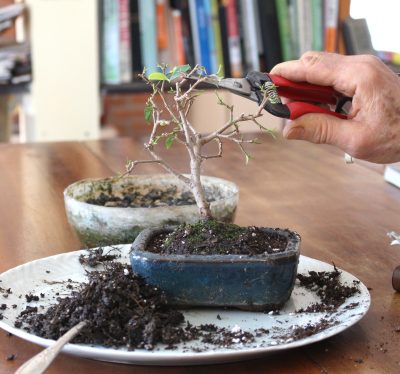 As far as science, I shorten stems where I want branching, usually just below the cut. Where I don’t want branching but want to decongest stems, I remove a stem or stems right to their base. I also remove any broken, dead, or crossing branches unless, of course, leaving them would be picturesque.
As far as science, I shorten stems where I want branching, usually just below the cut. Where I don’t want branching but want to decongest stems, I remove a stem or stems right to their base. I also remove any broken, dead, or crossing branches unless, of course, leaving them would be picturesque.